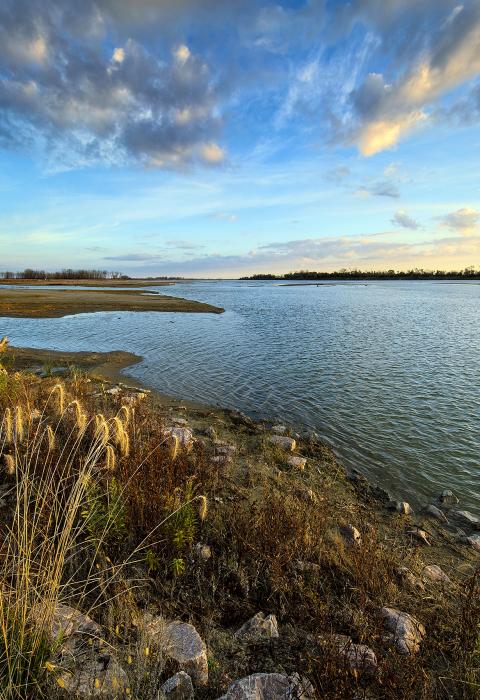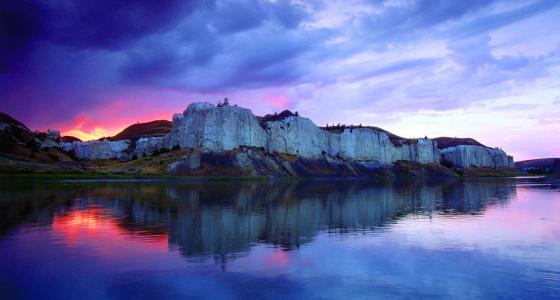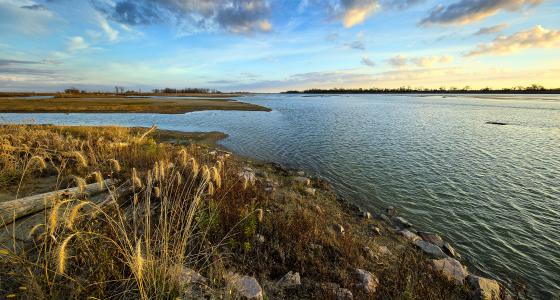Missouri River
Missouri River
Nebraska, South Dakota
This designation consists of two separate segments—from the Fort Randall Dam downstream to the backwaters of Lewis and Clark Lake and from Gavins Point Dam downstream to Ponca State Park. These are among the last free-flowing segments of the once "Mighty Mo" and still exhibit the river's dynamic character in its islands, bars, chutes, and snags.
Designated Reach
November 10, 1978, and May 24, 1991. From Gavins Point Dam, South Dakota, downstream to Ponca State Park, Nebraska. From Fort Randall Dam to Lewis and Clark Lake.
Outstandingly Remarkable Values
Culture
The Missouri River was a principle highway and commerce route from the times of the Paleo-Indians through later tribes such as the Mandans, Sioux, Omahas, and Poncas. The importance of the river as a travel route continues through European American westward migration and trade, including the Lewis and Clark Expedition and the fur trade and steamboat eras.
The Missouri National Recreational River’s storied past is well documented. The significant pre-historic and historic sites along the river provide unique educational and interpretive opportunities. Four sites are listed in the National Register of Historic Places, including Ponca Agency, Spirit Mound, Old Baldy, and Fort Randall.
Ecology
The unique ecosystem found in the Missouri National Recreational River comprises majestic geologic features, dynamic river processes, diverse ribbons of riparian vegetation, and nationally important fish and wildlife species. The landforms, stream channels, and native plant and animal communities provide a rare glimpse of the natural conditions experienced and encountered by early inhabitants.
The Missouri National Recreational River contains remnant wetlands, riparian cottonwood forests, bluff forests, and native prairies that provide habitat for many mammal and bird species. The continually changing banks and bluff faces exposed by the river provide nesting opportunities for darting bank and cliff swallows. Cottonwood forests, some of them over 100 years old, provide unique nesting and migratory stopover habitats within the Great Plains for a diversity of rare woodland songbird species and nesting and wintering habitat for the bald eagle.
Fish
The Missouri National Recreational River provides one of the last remnant examples of diverse, high-quality, shallow-water habitat in a large river system. This rare, intact assemblage is represented by aquatic habitat in and around sandbar pools, braided channels, large woody debris, and backwater and oxbow areas where native fish species still occur and reproduce. The western segments of the Missouri National Recreational River provide shallow water habitat that is free of the invasive Asian carp, which is becoming a very uncommon characteristic in the region. In addition to providing habitat for rare fish species, this assemblage of aquatic habitat is home to one of the highest diversities of mussel species in the region.
Geology
The Missouri River is the longest river in the United States contained in a unique geologic setting. The river marks the boundary between glaciated ice age terrain and sediments deposited by an ancient sea. Unique geologic features are found along the Missouri River, including the majestic chalk bluffs, unusual marine fossils such as the “Ponca Monster,” the culturally important Spirit Mound, the exemplary “ox-bow” Burbank Lake, and the rare Ionia Volcano.
Recreation
The Missouri National Recreational River provides a multitude of recreational opportunities that are regionally significant, including numerous types of motorized and nonmotorized boating, unparalleled birding, fishing, biking, hiking, hunting, photography, and artistic pursuit. Recreational activities on the Missouri and Niobrara rivers range from highly challenging paddlefish archery to simply floating with the current.
Scenery
The Missouri National Recreational River is a 100-mile stretch that represents a vestige of the untamed west. The recreational river provides a unique perspective on one of the greatest waterways in America through a contrast of natural textures and colors, rural farmsteads, meandering channels, shifting sandbars, and sheer chalkstone bluffs.
Wildlife
Flowing relatively unrestricted through the rural landscape between Nebraska and South Dakota, the Missouri National Recreational River supports an abundance of birds, mammals, amphibians, reptiles, and insects within a diverse riparian community that does not exist in other artificially channelized sections of the river or in reservoirs. The river provide one of the most important remaining complexes of natural sandbar and shallow foraging habitats on the Missouri River for the federally endangered interior least tern and threatened piping plover. These in-river features host a multitude of other migrating and nesting waterfowl, marsh birds, and shorebirds. The sandbars serve as a migration stopover for many bird species, providing an integral component of their migratory flyway. The adjacent riparian woodlands along both banks are equally important to a great diversity of songbirds and raptors. In addition to the bird species, the diverse, shallow water and riparian habitat of the Missouri National Recreational River also supports several rare amphibians and reptiles.



